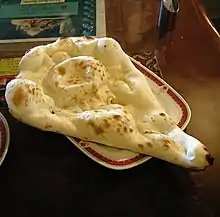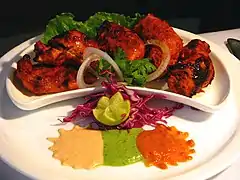 | |
| Type | Spiced curry stew |
|---|---|
| Place of origin | India |
| Region or state | South India |
| Serving temperature | Hot |
| Main ingredients | Tamarind broth, lentils, vegetables |
| 139 kcal (582 kJ) | |
Sambar (Tamil: [saːmbaːɾ] ⓘ, romanized: Sāmbār), known as Kuzhambu in TamilNadu, is a lentil-based vegetable stew, cooked with pigeon pea and tamarind broth.[1] It is popular in South Indian, Sri Lankan and Maldivian cuisines. The stew has been adapted into Burmese cuisine as a popular accompaniment to Burmese curries.[2]
History
According to food historian K. T. Achaya, the earliest extant mention of sambar in literature can be dated to the 17th century in Tamil Nadu.[3]
The word sambar (சாம்பார்) stems from the Tamil word champāram (சம்பாரம்).[4]
A Tamil inscription of 1530 CE,[5][6] shows the use of the word champāram in the sense of meaning a dish of rice accompanying other rice dishes or spice ingredients with which a dish of vegetable rice is cooked:
அமுதுபடி கறியமுது பல சம்பாரம் நெய்யமுதுள்ப்பட தளிகை ஒன்றுக்கு பணம் ஒன்றாக
Amutupaṭi kaṟiyamutu pala campāram neyyamutuḷppaṭa taḷikai oṉṟukku paṇam oṉṟāka.
Cooked rice offerings, including curry rice (pepper rice or vegetable rice), many types of spiced rice (pala champaaram) and ghee rice, at the rate of one pa’nam (a denomination of money) per one portion.
Another story about its origin states that the recipe for sambar can be traced to Maratha ruler Chhatrapati Sambhaji Raje Bhonsale who attempted to make dal for himself when his head chef was away. He loved his own concoction which was then referred to as 'Sambar'. [7] [8] [9]
Regional variations
Sambar is variously called thizone chinyay hin (သီးစုံချဉ်ရည်ဟင်း; lit. 'assorted vegetables sour soup'), thizone pe kala hin (သီးစုံပဲကလားဟင်း, lit. 'assorted vegetables chickpea soup'), or derivatives like thizone hin or pe kala hin in the Burmese language. The Burmese version incorporates dried salted fish and a variety of vegetables including eggplants, okra, moringa, gourd, green beans, and potatoes in a soup base of pureed chickpeas, which is seasoned with ripe tamarind, curry leaf, pyindawthein leaf, masala, cumin, chilies, onions and garlic.[2][10] In southern states of India namely Karnataka, Andhra Pradesh, Telangana, Kerala and Tamil Nadu, Sambar is made using different vegetables and fruits along with lentils or coconut. Each region has its own version of making sambar; even though the same vegetables are used, the condiments and ingredients, and the method differ regionwise.[11] In Tulu speaking areas of coastal Karnataka coconut is predominantly used to prepare Koddel(Sambar). The grated coconut is ground with spices to form a paste which is added to vegetables boiled.[12]
British Indian Restaurant (BIR) version
The 'Samber' is a staple of British curry houses, where it is served in the form of a thicker sauce than the original, with meat added to the dish. Typically it is hot, sour, and, like the original dish, contains lentils.[13]
See also
References
- ↑ Mathai, Kamini (26 September 2014). "Sambar: the great Tamil dish of Maharashtrians". The Times of India. Archived from the original on 8 July 2023. Retrieved 9 January 2022.
- 1 2 "သီးစုံပဲကုလားဟင်း၊ ငါးခြောက်မွှကြော် ၊ငရုတ်သီးဆားထောင်း". Mizzima (in Burmese). 3 December 2016. Archived from the original on 8 July 2023. Retrieved 29 December 2021.
- ↑ G. J. V. Prasad (2017). "Idli, Dosai, Sambar, Coffee: Consuming Tamil Identity". In Shweta Rao Garg; Deepti Gupta (eds.). The English Paradigm in India: Essays in Language, Literature and Culture. Springer Singapore. pp. 98–99. ISBN 978-981-10-5332-0. Archived from the original on 26 October 2023. Retrieved 18 May 2018.
- ↑ Velswamy, Jayalekshmy (2 April 2015). 53 Healthy Lunch Box Recipes for Babies,Toddlers and Kids. Bumps n Baby. Archived from the original on 8 July 2023. Retrieved 19 August 2022.
- ↑ South Indian Inscriptions vol.4. New Delhi: Archaeological Survey of India. 1986.
- ↑ "South Indian Inscriptions Vol 04 1923".
- ↑ "Sambar: the great Tamil dish of Maharashtrians". Times Of India. Archived from the original on 31 August 2018. Retrieved 26 September 2014.
- ↑ "The sambar you eat your idlis with is actually Maharashtrian". Gulf News. Archived from the original on 24 November 2021. Retrieved 14 November 2021.
- ↑ "This Link Between Sambhar And Thanjavur Marathas Would Take You By Surprise". NDTV Food. Archived from the original on 5 January 2023. Retrieved 5 January 2023.
- ↑ duwunkyal (30 June 2021). "ပဲကုလား ဟင်းချက်နည်းလေးပါ". Duwunkyal Blog (in Burmese). Archived from the original on 29 December 2021. Retrieved 29 December 2021.
- ↑ Hebbars kitchen. "Sambar Recipe South Indian Vegetable Sambar in Cooker – 15 Mins". Archived from the original on 4 April 2023. Retrieved 4 April 2023.
- ↑ DNA,English Daily Newspaper. "The sambar saga: On the provenance and many variations of a south Indian staple". Archived from the original on 4 August 2023. Retrieved 5 August 2023.
- ↑ "Samber Restaurant Curry Recipe".


